|
| |
Jazz Violin
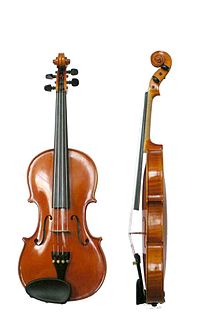 Four-stringed
musical instrument tuned in fifths, played with a bow, and held between
the shoulder and the chin Four-stringed
musical instrument tuned in fifths, played with a bow, and held between
the shoulder and the chin
It is hard to believe that this small instrument,
made of simple pieces of wood cut out and glued together, consisting of only
four chords, and whose sound range and volume are relatively low, has acquired
such prominence in the world of music. The prodigy is one of the
incomprehensible phenomena of the history of mankind!
The violin,
which developed from its primitive form of fiddler’s instrument to accompany
singing and dancing, reached an unequalled level of perfection in only a few
decades. It became, in the hands of great musicians, the preferred instrument
for expressing creative imagination.
The violin indeed was to prove itself both as a solo and as a concert
instrument.
It is no easy task to speak equitably of the
immensely rich history of the violin, nor of its music and its masters. We shall
attempt, however, to cover the basic elements related to the vast complexity of
what is denominated "violin - The
Rite of Strings
Jazz Violin Technique -
For
the fiddle player, jazz has several challenging aspects which set it apart from
most folk styles. Each number in a jazz performance starts and ends with a
melody which is played more or less "straight" (as written), but the bulk of the
number is made up of improvised solos which, whilst following the basic chord
sequence, will have little if anything to do with the original tune. This is the
opportunity for the soloist to state and develop his own ideas and to
inter-react with the rest of the band. Each solo may run several times round the
sequence ,and occasionally the band will do "fours", where four bar solos are
alternated between musicians. Hopefully the excitement will mount as each
soloist tries to copy and elaborate on the other's previous effort.
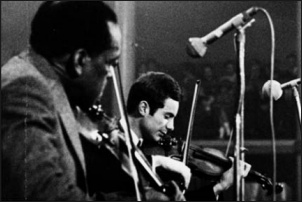  Stuff
Smith was an African-American jazz
violinist. Born in Portsmouth, Ohio, Smith first gained notice as a musician
with Alphonso Trent's orchestra in the '20s. After marrying and settling in
Buffalo, he teamed with Jonah Jones, who became a friend for life. Their band
became a hit at New York City's Onyx Club on 52nd Street and recorded such
popular tunes as I'se A Muggin and If You'se A Viper. Smith went to Hollywood in
1938 to make the film Swing Street and was slow to return to his work in New
York. As a result, the job with Jones ended and Smith's career slowed down
although he worked regularly in New York and Chicago. He played in a trio format
in the '40s, then moved to California in the '50s and most often performed solo.
Perhaps the most influential of early jazz violinists, Stuff Smith said that his
chief influence was Louis Armstrong and that he used the bow "like a horn player
uses breath control." He approached the violin somewhat in the Joe Venuti style,
a forceful bowing technique and swing-era rhythmic direction. He became a
popular performer in Europe in the '60s and died in Munich, Sept. 25, 1967.
(Left - Stuff with Jean Luc Ponty) Stuff
Smith was an African-American jazz
violinist. Born in Portsmouth, Ohio, Smith first gained notice as a musician
with Alphonso Trent's orchestra in the '20s. After marrying and settling in
Buffalo, he teamed with Jonah Jones, who became a friend for life. Their band
became a hit at New York City's Onyx Club on 52nd Street and recorded such
popular tunes as I'se A Muggin and If You'se A Viper. Smith went to Hollywood in
1938 to make the film Swing Street and was slow to return to his work in New
York. As a result, the job with Jones ended and Smith's career slowed down
although he worked regularly in New York and Chicago. He played in a trio format
in the '40s, then moved to California in the '50s and most often performed solo.
Perhaps the most influential of early jazz violinists, Stuff Smith said that his
chief influence was Louis Armstrong and that he used the bow "like a horn player
uses breath control." He approached the violin somewhat in the Joe Venuti style,
a forceful bowing technique and swing-era rhythmic direction. He became a
popular performer in Europe in the '60s and died in Munich, Sept. 25, 1967.
(Left - Stuff with Jean Luc Ponty)
 Eddie
South - At the time, classical positions
were not open to Black violinists in the 1920s, so South learned to play jazz
(helped out by Darnell Howard). In the early to mid-1920s, he worked in Chicago
with Jimmy Wade's Syncopators, Charles Elgar and Erskine Tate. In 1928, a visit
to Europe (where he studied at the Paris Conservatoire) made a deep impression
on the violinist, particularly Budapest; later on, he would often utilize gypsy
melodies as a basis for jazz improvising. In 1931, South returned to
Chicago, where his regular band included bassist Milt Hinton. In 1937, while in
Paris he recorded with Django Reinhardt and Stephane Grappelli. South never had
a major breakthrough commercially in his American career. Classically trained,
fluent in several styles including swing, gypsy and Latin; he favored a warm,
lyrical sound; popular in Europe, where racial discrimination did not hinder his
style. He did work on radio and television but spent most of his life in
relative obscurity, playing in New York, Los Angeles and Chicago. In later years
he recorded for Chess and Mercury, and also made a final set released by Trip.
South's other early recordings (covering 1927-41) have been reissued on a pair
of Classics CDs. One of the top violinists of the pre-bop era South was a
brilliant technician who, were it not for the universal racism of the time,
would probably have been a top classical
violinist. Eddie
South - At the time, classical positions
were not open to Black violinists in the 1920s, so South learned to play jazz
(helped out by Darnell Howard). In the early to mid-1920s, he worked in Chicago
with Jimmy Wade's Syncopators, Charles Elgar and Erskine Tate. In 1928, a visit
to Europe (where he studied at the Paris Conservatoire) made a deep impression
on the violinist, particularly Budapest; later on, he would often utilize gypsy
melodies as a basis for jazz improvising. In 1931, South returned to
Chicago, where his regular band included bassist Milt Hinton. In 1937, while in
Paris he recorded with Django Reinhardt and Stephane Grappelli. South never had
a major breakthrough commercially in his American career. Classically trained,
fluent in several styles including swing, gypsy and Latin; he favored a warm,
lyrical sound; popular in Europe, where racial discrimination did not hinder his
style. He did work on radio and television but spent most of his life in
relative obscurity, playing in New York, Los Angeles and Chicago. In later years
he recorded for Chess and Mercury, and also made a final set released by Trip.
South's other early recordings (covering 1927-41) have been reissued on a pair
of Classics CDs. One of the top violinists of the pre-bop era South was a
brilliant technician who, were it not for the universal racism of the time,
would probably have been a top classical
violinist.
 Joe
Venuti, a classically trained violinist
who switched to jazz, worked and recorded with Paul Whiteman, the Dorsey
Brothers, Bing Crosby, Red Nichols Tommy Dorsey and just about every major jazz
figure from the 1920's on. His "Venuti's Blue Four" recordings with Eddie Lang
are recognized jazz classics. He was elected to the Downbeat All-Time Swing Band
in 1936. He led various jazz groups in later years including one that featured a
just-starting young jazz singer named Kay Starr. Joe
Venuti, a classically trained violinist
who switched to jazz, worked and recorded with Paul Whiteman, the Dorsey
Brothers, Bing Crosby, Red Nichols Tommy Dorsey and just about every major jazz
figure from the 1920's on. His "Venuti's Blue Four" recordings with Eddie Lang
are recognized jazz classics. He was elected to the Downbeat All-Time Swing Band
in 1936. He led various jazz groups in later years including one that featured a
just-starting young jazz singer named Kay Starr.
Venuti's legendary (some would say outrageous) sense of
humour shown through in the joy of his instrument in much the same way that Fats
Waller's humour did. Everyone sounded better and, certainly happier, when they
worked with Venuti.
One of Venuti's most infamous gags was when he called up 26
tuba players in Hollywood and told them about a gig in town that he just made
up. They all showed up for the non-existent job, but Venuti ended up having to
pay for it when the union found out about it. His playing was easily more
engaging than his sense of humour.
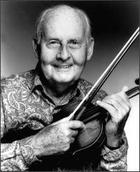 One
of the all-time great jazz violinists (ranking with
Joe Venuti and
Stuff Smith as one of the big three of pre-bop),
Stéphane Grappelli's
longevity and consistently enthusiastic playing did a great deal to establish
the violin as a jazz instrument. He was originally self-taught as both a
violinist and a pianist, although during 1924-28 he studied at the Paris
Conservatoire. Grappelli played in movie theaters and dance bands before meeting
guitarist
Django Reinhardt in 1933. They hit it off musically from the start even
though their lifestyles (Grappelli was sophisticated while
Django was a gypsy) were very different. Together as
Quintet of the Hot Club of France (comprised of violin, three acoustic
guitars and bass) during 1933-39 they produced a sensational series of
recordings and performances. During a London engagement in 1939, World War II
broke out.
Reinhardt rashly decided to return to France but Grappelli stayed in
England, effectively ending the group. The violinist soon teamed up with the
young pianist
George Shearing in a new band that worked steadily through the war. In 1946,
Grappelli and
Reinhardt had the first of several reunions although they never worked
together again on a regular basis (despite many new recordings). Grappelli
performed throughout the 1950s and '60s in clubs throughout Europe and, other
than recordings with
Duke Ellington (Violin
Summit) and
Joe Venuti, he remained somewhat obscure in the U.S. until he began
regularly touring the world in the early '70s. Since then Grappelli has been a
constant traveler and a consistent poll-winner, remaining very open-minded
without altering his swing style; he has recorded with
David Grisman,
Earl Hines,
Bill Coleman, Larry Coryell,
Oscar Peterson,
Jean Luc Ponty and McCoy Tyner among many others. Active up until near the
end, the increasingly frail Grappelli remained at the top of his field even when
he was 89. His early recordings are all available on Classics CDs and he
recorded quite extensively during his final three decades. One
of the all-time great jazz violinists (ranking with
Joe Venuti and
Stuff Smith as one of the big three of pre-bop),
Stéphane Grappelli's
longevity and consistently enthusiastic playing did a great deal to establish
the violin as a jazz instrument. He was originally self-taught as both a
violinist and a pianist, although during 1924-28 he studied at the Paris
Conservatoire. Grappelli played in movie theaters and dance bands before meeting
guitarist
Django Reinhardt in 1933. They hit it off musically from the start even
though their lifestyles (Grappelli was sophisticated while
Django was a gypsy) were very different. Together as
Quintet of the Hot Club of France (comprised of violin, three acoustic
guitars and bass) during 1933-39 they produced a sensational series of
recordings and performances. During a London engagement in 1939, World War II
broke out.
Reinhardt rashly decided to return to France but Grappelli stayed in
England, effectively ending the group. The violinist soon teamed up with the
young pianist
George Shearing in a new band that worked steadily through the war. In 1946,
Grappelli and
Reinhardt had the first of several reunions although they never worked
together again on a regular basis (despite many new recordings). Grappelli
performed throughout the 1950s and '60s in clubs throughout Europe and, other
than recordings with
Duke Ellington (Violin
Summit) and
Joe Venuti, he remained somewhat obscure in the U.S. until he began
regularly touring the world in the early '70s. Since then Grappelli has been a
constant traveler and a consistent poll-winner, remaining very open-minded
without altering his swing style; he has recorded with
David Grisman,
Earl Hines,
Bill Coleman, Larry Coryell,
Oscar Peterson,
Jean Luc Ponty and McCoy Tyner among many others. Active up until near the
end, the increasingly frail Grappelli remained at the top of his field even when
he was 89. His early recordings are all available on Classics CDs and he
recorded quite extensively during his final three decades.
Ray Nance, (vocal/cornet/violin. b. Dec
10, 1913 Chicago, IL, USA, d. Jan 28, 1976 New York, NY, USA) spent 20 years
with the Duke Ellington band as a trumpeter, singer, entertainer, and the only
violinist Ellington ever had. His specialty was the trumpet, but he was quite an
accomplished violinist. He was also an 'accomplished Drinker', whom Duke later
had to let go.
Svend Asmussen
(b. Feb 28, 1916 Copenhagen, Denmark - now in his 90s -- 2006) is still active.
He formed his first band when he was just 17 years old... a version of Joe
Venuti's 'Blue Four'. This Danish musician is rarely recalled, but his wonderful
lyricism earned him deserved acclaim, and still, he has a sense of the Blues
matched only by American Blacks. He was already playing the violin at age seven.
Made his professional debut in 1933, and made his first records as a leader in
1935. During the 1930s, he played with the 'Mills Brothers' and
"Fats" Waller , when they
visited Denmark during their European tours. In 1962, he recorded with John
Lewis. During his career, he not only played with Stephane Grappelli, but, on
one 1963 recording session (the "Duke Ellington's Jazz Violin Session") he
played viola alongside Joe Venuti and Ray Nance, who was also playing the violin
instead of his more usual Trumpet. There was also a 1966 "Violin Summit" concert
with Asmussen, Ponty, Grapelli, and
"Stuff" Smith. (A
visitor to this page, Mr. Joel Glassman has recalled that "it was recorded and
issued, but is now out of print. There is a recording called "Violin Summit" in
print, but it is not the 1966 concert".) Svend has also recorded with Toots
Thielemans, Lionel Hampton (1978) and with Stephane Grappelli. His character was
that of a clown, an entertainer, an intellectual and more. His musical interests
also spread into more complex orchestral forms.
 Jean
Luc Ponty Jean
Luc Ponty
Ponty was born in a family of classical musicians on September 29, 1942 in
Avranches, France. His father taught violin, his mother taught piano. At
sixteen, he was admitted to the Conservatoire National Supérieur de Musique
de Paris, graduating two years later with the institution's highest award,
Premier Prix. In turn, he was immediately hired by one of the major
symphony orchestras, Concerts Lamoureux, where he played for three
years.
While still a member of the orchestra in Paris, Ponty picked up a side gig
playing clarinet (which his father had taught him) for a college jazz band that
regularly performed at local parties. It proved a life-changing jumping-off
point. A growing interest in the jazz sounds of Miles Davis and
John Coltrane compelled him to take up the tenor saxophone. Fueled by
an all-encompassing creative passion, Jean-Luc soon felt the need to express his
jazz voice through his main instrument, the violin.
So it was that Ponty found himself leading a dual musical life:
rehearsing and performing with the orchestra while also playing jazz until 3 AM
at clubs throughout Paris. The demands of this doomed schedule eventually
brought him to a crossroads. "Naturally, I had to make a choice, so I took a
chance with jazz", says Jean-Luc
2 - Jean-Luc
Ponty is a pioneer and undisputed master of violin in the arena of jazz and
rock. Classically trained, with an unquenchable ability to swing when he wants
to, and consumed by a passion for tight structures and repeating ostinatos,
Ponty has been able to handle styles as diverse as swing, bop, free and modal
jazz, jazz-rock, world music and even country, mixing them up at will. Ponty was
born in a family of classical musicians on September 29, 1942 in Avranches,
France. At the age of 15, he was accepted into the Paris Conservatoire,
ultimately winning the premier prix at age 17. He played with the Concerts
Lamoureux Orchestra for three years. A growing interest in jazz brought him to
leading a dual musical life: rehearsing and performing with the orchestra while
also playing jazz at clubs throughout Paris in the night. Few at the time viewed
the instrument as having a legitimate place in the modern jazz vocabulary. With
a powerful sound that eschewed vibrato, Jean-Luc distinguished himself with
be-bop era phrasings and a punchy style influenced more by horn players than by
anything previously tried on the violin; nobody had heard anything quite like it
before. After a hitch in the French Army (1962-64), Ponty went completely over
to the jazz camp, leading quartets and trios in Europe and visiting the Monterey
Jazz Festival workshop in 1967. In the late 60s and early 70s he then toured and
recorded with Frank Zappa, the George Duke Trioa and the Mahavishnu Orchestra
and formed the free-jazz Jean-Luc Ponty Experience (1970-72). Afterwards he set
out on his own, compiling a long series of solo albums on Atlantic. On 1991's
Epic-released Tchokola, Ponty combined his acoustic and electric violins, for
the first time, with the powerful polyrhythmic sounds of West Africa. In 1995,
Ponty joined guitarist Al Di Meola and bassist Stanley Clarke to record an
acoustic album under the name The Rite of Strings. In 1997, Jean-Luc Ponty put
back together his group of Western and African musicians pursuing the new fusion
he started in 1991. Ponty also performed a highly acclaimed duet with bassist
Miroslav Vitous in December 99. In January 2000, he participated to Lalo
Schifrin's most recent recording with a big band, Esperanto.
 Aaron
Weinstein Named a “rising star
violinist” by Downbeat Magazine, Aaron Weinstein is quickly earning a reputation
as one of the finest jazz violinists of his generation. As a featured soloist,
Aaron has performed at Lincoln Center, Wolftrap Center for the Performing Arts,
Chicago's Orchestra Hall, the JVC Jazz Festival, the Iridium, Birdland, and
Django Reinhardt festivals in France, Iceland and New York City. Aaron has
performed and recorded with and an array of jazz masters including: Howard
Alden, Gene Bertoncini, Al Caiola, Scott Hamilton, Dick Hyman, Les Paul, Houston
Person, Bucky Pizzarelli, John Pizzarelli, Annie Ross, Warren Vache, Frank
Vignola, and Claude "Fiddler" Williams as well as legendary rock guitarist, Jay
Geils, New York Pops founder/conductor, Skitch Henderson. He is a recent
graduate of the Berklee College of Music in Boston, Massachusetts, where he was
awarded a full four-year talent-based scholarship. While still in high school,
he founded New Trier High School's Stephane Grappelli Tribute Trio, voted as the
nation's best high school instrumental jazz group by Downbeat Magazine in 2002.
Aaron has won various competitions including the 1998 and 2001 Illinois State
Fiddle Championships, making him the youngest performer ever to hold this title.
With the release of Aaron’s Arbors Records debut, "A Handful of Stars", (called
“the rebirth of the hot jazz violin” by Nat Hentoff) Aaron has become the
youngest jazz musician to have recorded as leader for this prestigious
traditional jazz record label.
Aaron's MySpace Aaron
Weinstein Named a “rising star
violinist” by Downbeat Magazine, Aaron Weinstein is quickly earning a reputation
as one of the finest jazz violinists of his generation. As a featured soloist,
Aaron has performed at Lincoln Center, Wolftrap Center for the Performing Arts,
Chicago's Orchestra Hall, the JVC Jazz Festival, the Iridium, Birdland, and
Django Reinhardt festivals in France, Iceland and New York City. Aaron has
performed and recorded with and an array of jazz masters including: Howard
Alden, Gene Bertoncini, Al Caiola, Scott Hamilton, Dick Hyman, Les Paul, Houston
Person, Bucky Pizzarelli, John Pizzarelli, Annie Ross, Warren Vache, Frank
Vignola, and Claude "Fiddler" Williams as well as legendary rock guitarist, Jay
Geils, New York Pops founder/conductor, Skitch Henderson. He is a recent
graduate of the Berklee College of Music in Boston, Massachusetts, where he was
awarded a full four-year talent-based scholarship. While still in high school,
he founded New Trier High School's Stephane Grappelli Tribute Trio, voted as the
nation's best high school instrumental jazz group by Downbeat Magazine in 2002.
Aaron has won various competitions including the 1998 and 2001 Illinois State
Fiddle Championships, making him the youngest performer ever to hold this title.
With the release of Aaron’s Arbors Records debut, "A Handful of Stars", (called
“the rebirth of the hot jazz violin” by Nat Hentoff) Aaron has become the
youngest jazz musician to have recorded as leader for this prestigious
traditional jazz record label.
Aaron's MySpace
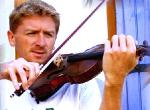 Christian
Garrick
is an improvising violinist and a composer with an
international reputation. He began playing the violin aged five, but first
moved through piano and drums before settling, at sixteen, on the violin full
time. By the age of eleven he was performing with Johnny Dankworth, Cleo Laine
and performed with Nigel Kennedy! He is, without doubt, the most accomplished
and expressive jazz violinist since Grappelli.
Christian studied at the Royal Academy of Music
between 1989 and 1994. He gained first-class honours in his Performers' Degree
and won the DipRAM in his post-graduate year. He has also been awarded the LRAM
and the ARAM. His tutors and mentors whilst at the R.A.M. included the great
unsung hero of British jazz violinists, John Van Derrick. Also among the
resident and visiting staff were Martin Speake, Hugh Fraser, Nick Ingam, Steve
Coleman, Jack Dejohnette, Huw Warren, Chucho Valdez, Arturo Sandoval, Gary
Peacock and Kenny Wheeler. Other jazz violinists having a strong influence are
Ziggy Seifert and Didier Lockwood. Chris has won the Benjamin Doniger
Prize, Lansdowne Studios Award, Modena Prize, and the Cleo Johnson Composition
Award. He also won admission to the International Association of the Schools of
Jazz in Siena, Italy in 1992. Son of Pianist Michael Garrick.
Chris is
also highly regarded for his work with the likes of The Brand New Heavies and
Brian Ferry, as well as appearing on a significant number of film and TV
soundtracks. He is also no stranger to the classical concert halls, but it is
his Jazz violin for which he is best known. A fluent and inventive player with a
string of awards to his name his subtle yet always driving playing is a
testament to a thoughtful but at the same time joyous approach to the music.
Featuring pianist Dave Gordan his quartet’s cd, “Different Strokes” was
described as “…the outstanding British album of the year..”.
Sunday Times. A true master of his instrument. “..exquisite
musician…violin superstar” Guardian. Christian
Garrick
is an improvising violinist and a composer with an
international reputation. He began playing the violin aged five, but first
moved through piano and drums before settling, at sixteen, on the violin full
time. By the age of eleven he was performing with Johnny Dankworth, Cleo Laine
and performed with Nigel Kennedy! He is, without doubt, the most accomplished
and expressive jazz violinist since Grappelli.
Christian studied at the Royal Academy of Music
between 1989 and 1994. He gained first-class honours in his Performers' Degree
and won the DipRAM in his post-graduate year. He has also been awarded the LRAM
and the ARAM. His tutors and mentors whilst at the R.A.M. included the great
unsung hero of British jazz violinists, John Van Derrick. Also among the
resident and visiting staff were Martin Speake, Hugh Fraser, Nick Ingam, Steve
Coleman, Jack Dejohnette, Huw Warren, Chucho Valdez, Arturo Sandoval, Gary
Peacock and Kenny Wheeler. Other jazz violinists having a strong influence are
Ziggy Seifert and Didier Lockwood. Chris has won the Benjamin Doniger
Prize, Lansdowne Studios Award, Modena Prize, and the Cleo Johnson Composition
Award. He also won admission to the International Association of the Schools of
Jazz in Siena, Italy in 1992. Son of Pianist Michael Garrick.
Chris is
also highly regarded for his work with the likes of The Brand New Heavies and
Brian Ferry, as well as appearing on a significant number of film and TV
soundtracks. He is also no stranger to the classical concert halls, but it is
his Jazz violin for which he is best known. A fluent and inventive player with a
string of awards to his name his subtle yet always driving playing is a
testament to a thoughtful but at the same time joyous approach to the music.
Featuring pianist Dave Gordan his quartet’s cd, “Different Strokes” was
described as “…the outstanding British album of the year..”.
Sunday Times. A true master of his instrument. “..exquisite
musician…violin superstar” Guardian.
 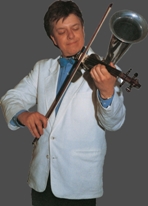 Mike
Piggott Jazz violinist is “One
of the best swing jazz Violin players active anywhere in the world” (Jazz Times
USA) and is the first fiddle player at ‘Jazz @ the Grainstore’. He is influenced
by Stephan Grappelli, Joe Venuti, and Stuff Smith and has recorded and broadcast
with a wide range of artists including Ralph McTell, Bert Jansch, Phil Collins,
John Etheridge, Gary Potter, and Bucky Pizzarelli. Mike
Piggott Jazz violinist is “One
of the best swing jazz Violin players active anywhere in the world” (Jazz Times
USA) and is the first fiddle player at ‘Jazz @ the Grainstore’. He is influenced
by Stephan Grappelli, Joe Venuti, and Stuff Smith and has recorded and broadcast
with a wide range of artists including Ralph McTell, Bert Jansch, Phil Collins,
John Etheridge, Gary Potter, and Bucky Pizzarelli.
"...one of the best swing
jazz fiddle players active anywhere" -
Jazz Times USA
"...demonstrates his mastery of the jazz violin" - Jazz UK
Mike Piggott has been a stalwart
member of the music scene for many years, having been involved not only in jazz
but also in the folk and rock worlds, notably recording 6 albums with Ralph
McTell, replacing John Renbourne in the re-formed Pentangle with which he
recorded 2 albums,
spending
two years with The Denny Laine Band, and
working with "Zox & The Radar Boys" an offshoot from Genesis). Mike is also a
soloist in Keith Nichols' Ragtime Orchestra,
which featured in the Bix Beiderbecke concert series at the Purcell Room and the
Queen Elizabeth Hall, as well as being in
constant demand in clubs, at festivals and on sessions. Above Mike plays the "Strohviol"
- an early recording violin which has a gramophone-type horn built into it. Look
out for his demo of Joe Venuti's '4-string bowing' technique.
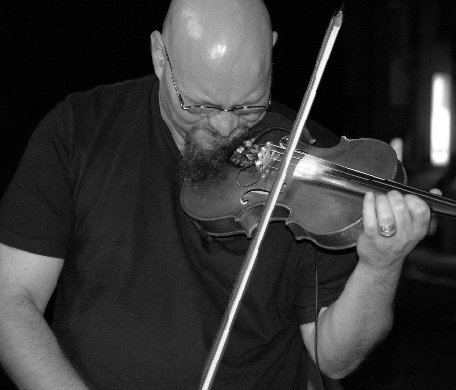 Stefano
Pastor from
Genoa - has graduated in violin and, with full marks, in Jazz. He followed his
studies with Claudio Marzorati, Carlo Pozzi, Piero Farulli,
Lorenzo Lugli, Piero Leveratto and attends Masters with Enrico Rava and Dave
Liebman. In 1982 wins the contest "Laboratorio Lirico Sperimerntale", and
for two years he performs with "Orchestra of Teatro di Alessandria". Since then
he played in many Orchestras such as the “Angelicum Symphony Orchestra” in
Milano sharing the stage with important soloists and directors as Josè Carreras,
Cecilia Gasdia, Simone Alaimo, Paul Badura- Skoda, Lev Markiz, Edardo Muller,
Massimo Biscardi, Daniele Gatti, Pietro Borgonovo. He takes part in Studio
to recordings with Massimo De Bernard, Mauro Ceccanti, the art-rock group
Picchio dal Pozzo and the popular singer-song- writer Paolo Conte. For the past
6 years he occupies first violin of the string quartet "Leon Battista Alberti",
recording often for Italian National television (RAI) and performing live
regularly. Stefano
Pastor from
Genoa - has graduated in violin and, with full marks, in Jazz. He followed his
studies with Claudio Marzorati, Carlo Pozzi, Piero Farulli,
Lorenzo Lugli, Piero Leveratto and attends Masters with Enrico Rava and Dave
Liebman. In 1982 wins the contest "Laboratorio Lirico Sperimerntale", and
for two years he performs with "Orchestra of Teatro di Alessandria". Since then
he played in many Orchestras such as the “Angelicum Symphony Orchestra” in
Milano sharing the stage with important soloists and directors as Josè Carreras,
Cecilia Gasdia, Simone Alaimo, Paul Badura- Skoda, Lev Markiz, Edardo Muller,
Massimo Biscardi, Daniele Gatti, Pietro Borgonovo. He takes part in Studio
to recordings with Massimo De Bernard, Mauro Ceccanti, the art-rock group
Picchio dal Pozzo and the popular singer-song- writer Paolo Conte. For the past
6 years he occupies first violin of the string quartet "Leon Battista Alberti",
recording often for Italian National television (RAI) and performing live
regularly.
At the present he devotes himself entirely to jazz music performing live with a
lot of important jazz musicians like Borah Bergman, Harry Beckett, George Haslam,
Paul Hession, Piero Leveratto, Maurizio Giammarco, Cristopher Culpo, Giancarlo
Schiaffini, Giorgio Dini, Giampaolo Casati, Claudio Capurro, Mauro Negri, Mario
Raja, Bruno Tommaso, Luciano Milanese, Nando De Luca e Alberto Tacchini.
In 2004 he issues the CD as leader “Una Notte in Italia” for the Italian label
Videoradio obtaining the favour of Italian and European critics. In the same
year he is assistant at orchestra director Mario Raja at the clinics of Siena
Jazz School. During 2005 he won 2nd prize at the prestigious “Rassegna
Giovani Musicisti” in Cervo (Italy) and is finalist at “International Arranging
and Composition Competition for Jazz Orchestra” with a work on Wayne Shorter,
soloist Claudio Fasoli. In 2006 he issues the second CD as leader named
Transmutations, by the English label SLAM Productions. The review of musical
research called “Suono Sonda” publishes a work written by Stefano Pastor and the
poetess Erika Dagnino entitled “Cicli”. This work becomes later a four movement
suite and it is issued in May 2007 with the title “Cycles” by SLAM. The
CD's "Holywell
Session - Live in Oxford" e "Helios Suite" both issued
by SLAM in 2007 came out from a period of concert and recording in England made
in 2006. The “Jazz Lighthouse” association, in collaboration with the
Genoa Commune, awarded to Pastor a special prize “for the research of new
expressive ways in jazz music”.
In 2007 releases “Uncrying
Sky” for Silta Records with Schiaffini, Dini and Rotella, a project based on
music and poem by Pastor himself. He gives a series of concert in duo,
documented by RAI - Radio tre, with the pianist Borah Bergmen from NYC and
recorded a new joint CD that will be issued in 2008.
He was placed seventh, as new best
talent, at the Italian critic's referendum "Top Jazz" in 2007.
He has also devoted himself to
teaching for many years.
David
Camrass - Acoustic and Electric Violin
contact details
0113 278 8872
0791 378 1993 associates with
Gitane
Hot-club jazz quartet formed in 1999. Gitane play
hot-club swing, Latin-american and European gypsy jazz in a rhythmic and
passionate style reminiscent of the Hot-Club Quintet of Django Reinhardt and
Stephane Grappelli. They are: Michael Pavanne (guitar), Mick Taylor (guitar),
Dave Camrass (violin), Laurie Johnstone (bass guitar, flute). tel: 01524 380521
or Mob: 07890 701930
 Billy
Thompson
Classically
trained from the age of 8, Billy's mind would often wander from the strict
training required in Classical music and he would often ask his Mother to 'Name
a tune, any tune' which he would then play by ear. Billy ambled through the
'grade' system whilst very much enjoying his time with the Cheshire County Youth
Orchestra - touring the U.S.A. twice and Germany. Billy's first band was
whilst in the 6th form at Neston Comprehensive School and were called
Diversion. They were a promising 'indie' type band with songs penned by good
friend Edward Humphreys. Billy played both violin and mandolin. Although
tempted to 'give the band a go' the 4-piece split up to go to separate
Universities. During this time, Billy also used to go busking regularly in
Birkenhead and Chester with good friend Billy Leng playing a mixture of
Leng originals and acoustic folk songs by Bob Dylan, Mike Scott, The Wonderstuff
and The Manic Street Preachers amongst others. After a year at the
University of Wales College Cardiff studying Music, Billy transferred to a more
practical degree course at the Royal Welsh College of Music and Drama where he
studied with violin professors Barry Haskey
and
Dona Lee Croft.
Here he also studied Jazz and
Improvisation with piano legend Keith Tippett. Throughout
college, Billy played with many different types of bands, mainly just trying to
be the best he could be at improvising. Jazz was/is obviously the ultimate form
of improvising and will always be part of Billy's quest to master improvisation
on the violin. It was not long after graduating with an honours degree in
Music that Billy was offered an extended residency at the 5-star 'Royal Abjar
Hotel' in Dubai performing Jazz Billy
Thompson
Classically
trained from the age of 8, Billy's mind would often wander from the strict
training required in Classical music and he would often ask his Mother to 'Name
a tune, any tune' which he would then play by ear. Billy ambled through the
'grade' system whilst very much enjoying his time with the Cheshire County Youth
Orchestra - touring the U.S.A. twice and Germany. Billy's first band was
whilst in the 6th form at Neston Comprehensive School and were called
Diversion. They were a promising 'indie' type band with songs penned by good
friend Edward Humphreys. Billy played both violin and mandolin. Although
tempted to 'give the band a go' the 4-piece split up to go to separate
Universities. During this time, Billy also used to go busking regularly in
Birkenhead and Chester with good friend Billy Leng playing a mixture of
Leng originals and acoustic folk songs by Bob Dylan, Mike Scott, The Wonderstuff
and The Manic Street Preachers amongst others. After a year at the
University of Wales College Cardiff studying Music, Billy transferred to a more
practical degree course at the Royal Welsh College of Music and Drama where he
studied with violin professors Barry Haskey
and
Dona Lee Croft.
Here he also studied Jazz and
Improvisation with piano legend Keith Tippett. Throughout
college, Billy played with many different types of bands, mainly just trying to
be the best he could be at improvising. Jazz was/is obviously the ultimate form
of improvising and will always be part of Billy's quest to master improvisation
on the violin. It was not long after graduating with an honours degree in
Music that Billy was offered an extended residency at the 5-star 'Royal Abjar
Hotel' in Dubai performing Jazz
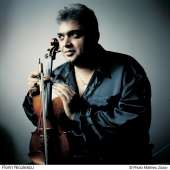 Florin
Niculescu -
Video Florin
Niculescu -
Video
Florin Niculescu is
one of the finest violinists on the international jazz scene today. Through many
musical collaborations this
captivating musician has developed a distinct sound
and language, building on a solid classical education and linking gypsy
traditions to diverse forms of jazz. His impeccable technique and outstanding
virtuosity – praised by fellow musicians and
audiences alike – are not a means
to an end but a way of expressing his artistic personality.
Minor Swing with Laurent Korcia
Jerry Goodman is an American
violinist best known for playing in the fusion jazz bands
The Flock and
Mahavishnu Orchestra. After his 1970 appearance on
John McLaughlin's album My Goals Beyond, he became a
member of McLaughlin's
Mahavishnu Orchestra until the band broke up in 1973. After
Mahavishnu, he recorded three solo albums for
Private Music -- On the Future of Aviation, Ariel,
and It's Alive -- and went on tour with his own band, as
well as with
Shadowfax and The
Dixie Dregs. He scored
Lily Tomlin's
The Search For Signs Of Intelligent Life In The Universe
and is the featured violinist on numerous film soundtracks,
including
Billy Crystal's
Mr. Saturday Night. His violin can be heard on more than
fifty albums from artists ranging from
Toots Thielemans to
Hall & Oates to
Styx. After a long absence from the public eye, he appeared
on Gary Husband’s Force Majeure: Live at the Queen Elizabeth
Hall in 2005.
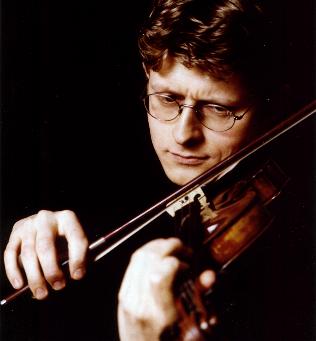 Tim
Kliphuis ranks among
the world’s finest jazz violinists. Hailing from Holland, his
first international recognition came after he joined Belgian
gypsy jazz guitarist Fapy Lafertin in 1999. Their
co-operation resulted in three acclaimed CDs and tours in Europe
and the UK. Since he embarked
on a solo career in 2004, Kliphuis has performed with such
world-renowned jazz players as Les Paul, Bob Wilber, Herb
Geller, Bucky Pizzarelli and Stochelo Rosenberg. He has
played jazz festivals all over the world, including North Sea
Jazz, La Villette (Paris), Edinburgh Jazz Festival,
Djangofests in Seattle, Chicago and Philadelphia and clubs such
as Ronnie Scott’s, Pizza Express (London) and Iridium
Jazz Club (New York). With his new London-based Quartet,
featuring Len Skeat, Mitch Dalton and James Pearson, he recorded
The Grappelli Tribute (2005) which was released to
rave reviews. This line-up enables Tim to fuse more and more of
his classical background into jazz. Tim's
Grappelli Workshops often accompany concerts on tour.
He is now working his broad teaching experience into a violin
tuition book about Stéphane Grappelli's style. Tim
Kliphuis ranks among
the world’s finest jazz violinists. Hailing from Holland, his
first international recognition came after he joined Belgian
gypsy jazz guitarist Fapy Lafertin in 1999. Their
co-operation resulted in three acclaimed CDs and tours in Europe
and the UK. Since he embarked
on a solo career in 2004, Kliphuis has performed with such
world-renowned jazz players as Les Paul, Bob Wilber, Herb
Geller, Bucky Pizzarelli and Stochelo Rosenberg. He has
played jazz festivals all over the world, including North Sea
Jazz, La Villette (Paris), Edinburgh Jazz Festival,
Djangofests in Seattle, Chicago and Philadelphia and clubs such
as Ronnie Scott’s, Pizza Express (London) and Iridium
Jazz Club (New York). With his new London-based Quartet,
featuring Len Skeat, Mitch Dalton and James Pearson, he recorded
The Grappelli Tribute (2005) which was released to
rave reviews. This line-up enables Tim to fuse more and more of
his classical background into jazz. Tim's
Grappelli Workshops often accompany concerts on tour.
He is now working his broad teaching experience into a violin
tuition book about Stéphane Grappelli's style.
Not all violinists were males.
Ginger Smock (1920-1995) was one very talented, and beautiful lady
violinist. Sadly, Ginger is rarely recalled these days. She was equally adept
with the Classics, and with Jazz, where her style was greatly influenced by
"Stuff" Smith's work. At times, she was called "The Lovely Lady with the
Violin", or "The Bronze Gypsy and her Violin", and in Hawaii, she was "The
Sweetheart of the Strings". In Los Angeles, Smock recorded with some 'Rhythm and
Blues' groups, performed with the Los Angeles Symphony, and appeared on
television (also had her own TV show). During the 1960s and '70s, Ginger worked
as a concertmaster for various Las Vegas hotels where she backed many of the
leading stars of the day including Sammy Davis, Jr. (In 2005, 'AB Fable', a
small British company released a CD with some rare recordings of Ginger Smock.
Previously, her only available recordings were from a 1946 session with the
'Vivien Garry Quintet', where she played a solid body Rickenbacher electric
violin.)
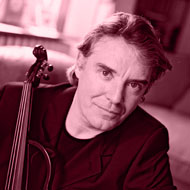 Didier
Lockwood (born
February 11,
1956) is a French jazz violinist. Didier
Lockwood (born
February 11,
1956) is a French jazz violinist.
He was born in
Calais and studied classical violin and composition at
the Calais Conservatory. However, he became enamored of rock
and roll and quit his studies in
1972 to form a
progressive rock group called
Magma with his brother Francis, pianist. They played
together for three years, but Didier was soon entranced by
the improvisation of
Jean-Luc Ponty on
Frank Zappa's King Kong album. Lockwood was also
influenced by Polish violinist
Zbigniew Seifert and, of course,
Stéphane Grappelli, whom he joined on tour.
He has also played with Quebecois fusion group
Uzeb on their Absolutely Live album.
He is famous for exploring new musical environments and for
performing various sound imitations on his amplified violin,
such as seagulls or trains.Didier Lockwood created a string instruments improvisation
school, CMDL (Centre des Musiques Didier Lockwood), in 2001.
He is married to singer Caroline
Casadesus Throughout 2006 Didier has been touring with
Martin Taylor the Jazz guitarist. In these performances
it is noticable to see that he is very involved in
improvisation.
Didier Lockwood has had a diverse
career, ranging from fusion to swing and advanced hard bop. In the 1980s, he was
considered the next in a line of great French violinists after
Stephane Grappelli and Jean-Luc Ponty, but he maintained a fairly low
profile in the 1990s. Lockwood began studying violin when he was six. Ten years
later, he stopped his formal training and joined a rock group. He played in
Paris with
Aldo Romano and Daniel Humair, among others, met
Grappelli and toured with him. He had a fusion group called Surya and
recorded with
Tony Williams around the same period of time (1979). Didier Lockwood played
in the United States on several occasions in the 1980s and recorded an acoustic
album in 1986 with fellow violinists
John Blake and
Michal Urbaniak.
 Fiona
Pears Fiona
Pears
Recent times have been an exciting and
hectic for Christchurch NZ violinist Fiona Pears. After doing a series of sell
out concerts around New Zealand she then toured Australia including the Sydney
Opera House and Japan.
Fiona then travelled to London where she performed in various jazz concerts
including a Grapelli/Django tribute show with John Ethridge and a concert at the
100 club in London for the Gipsy Jazz revivalist Dis Disley.
She has
opened for artists such as Tony Bennett, Ottmar Liebert and the late Victor
Borge.
Fiona's music is a fiery melting pot of
flavours, Latin, Jazz, World Music as well as some hot traditional Gypsy
favourites. Fiona is an electrifying and visual performer who thrills audiences
wherever she plays. Her band is a mix of fantastic Kiwi and English musicians.
Her latest venture saw Fiona record and perform a solo for BBC television.
After being back in NZ for 6 weeks she is to return to London to start a world
tour with Hayley. During this time Fiona will also be working on compositions
for her next solo CD.
Fiona
Pears 2 - Jazz Eddie - I saw Fiona jamming with guitarist
Louis Stewart in a pub in Dublin in 2003 and she has fine lyrical style and a
superb improviser yielding some truly wonderful Ellington interpretations, -
catch her when you can. Check out her video of In a Sentimental mood, and the
Grapelli Gypsy Jazz medley with John Etheridge. -
Video link
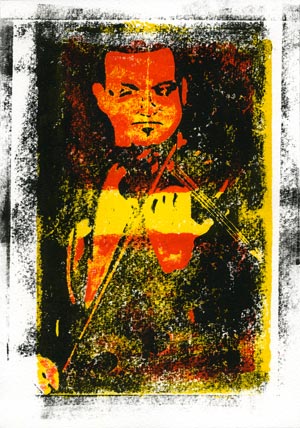 George
Washingmachine George
Washingmachine
Working the jazz traps of
Sydney for years, George is a long time member of the “Bonza Vista
Social Club” up their with legendary lights such as James Morrison, Bob
Barnard, Ian Date, Dan Barnett and Monica Trapaga. George has also
supported international performing stars such as Sarah Vaughan, Al
Jarreau, Leo Kottke, Leon Redbone, Lenny Henry, to name a few.
Besides appearing at many
national & international jazz festivals, George is also kept busy with
touring. George. So if you’re looking for a swinging experience,
underpinned by a delightful sense of humour and superb musicality, then
George is your man.
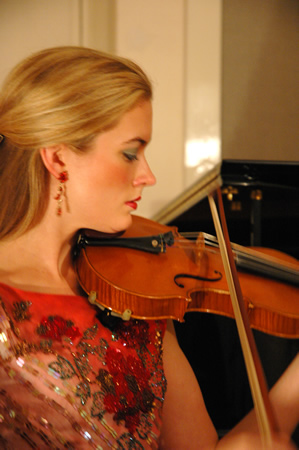
Lizzie
Ball
Lizzie’s has recently completed a tour to Finland
with her quartet, and a tour to Colombia in March with her Latin Trio Classico
Latino where they performed several sell out recitals in venues that include the
Theatro Colon Opera House, and the Shakespeare Institute in Bogota. Their trip
included National TV and Radio appearances, and a series of teaching
masterclasses for the British Council to the pupils of Ibague Music Academy-the
best music school in Colombia for young students age 7 to 18. Future plans
include a combined recital with the Chilingirian Quartet in the Boxgrove
Festival and further recitals with Morgan Szymanski. The showcase of the long
awaited String Eclectica project with Bernard Gregor-Smith (cellist of the
acclaimed recently retired Lindsay quartet) will be in November 2006 together
with renowned jazz guitarists Pete Oxley and Luis D’Agostino, beginning with a
performance in the Holywell Room, Oxford. 24/11/06
IPANEMA: VIOLIN AND SAX LATIN JAZZ DUO -
Together with Heather Hoyle (saxophone) the girls can provide any
event with a fabulous atmosphere of acoustic violin and sax renditions of jazz
standards and Latin jazz as they walk in between the guests, tall and tanned and
long and lovely.
Since her graduation from
Cambridge University in 2002, she has performed chamber music with The Covent
Garden Soloists, orchestral work with The Philharmonia, has led the string
section for Simply Red's 2005 world tour, and recently was 'Gothed Up' to play
with Meatloaf at the Albert Hall.
Jazz Violin Lessons
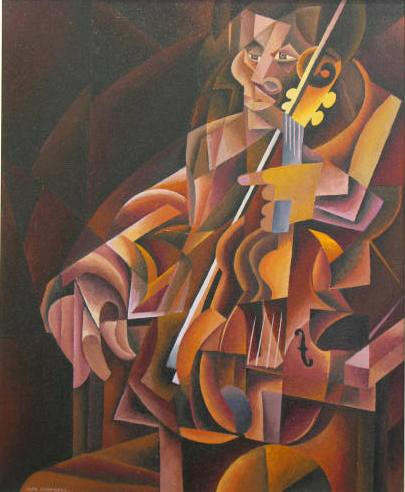 
|
 Tim
Kliphuis ranks among
the world’s finest jazz violinists. Hailing from Holland, his
first international recognition came after he joined Belgian
gypsy jazz guitarist Fapy Lafertin in 1999. Their
co-operation resulted in three acclaimed CDs and tours in Europe
and the UK. Since he embarked
on a solo career in 2004, Kliphuis has performed with such
world-renowned jazz players as Les Paul, Bob Wilber, Herb
Geller, Bucky Pizzarelli and Stochelo Rosenberg. He has
played jazz festivals all over the world, including North Sea
Jazz, La Villette (Paris), Edinburgh Jazz Festival,
Djangofests in Seattle, Chicago and Philadelphia and clubs such
as Ronnie Scott’s, Pizza Express (London) and Iridium
Jazz Club (New York). With his new London-based Quartet,
featuring Len Skeat, Mitch Dalton and James Pearson, he recorded
The Grappelli Tribute (2005) which was released to
rave reviews. This line-up enables Tim to fuse more and more of
his classical background into jazz. Tim's
Grappelli Workshops often accompany concerts on tour.
He is now working his broad teaching experience into a violin
tuition book about Stéphane Grappelli's style.
Tim
Kliphuis ranks among
the world’s finest jazz violinists. Hailing from Holland, his
first international recognition came after he joined Belgian
gypsy jazz guitarist Fapy Lafertin in 1999. Their
co-operation resulted in three acclaimed CDs and tours in Europe
and the UK. Since he embarked
on a solo career in 2004, Kliphuis has performed with such
world-renowned jazz players as Les Paul, Bob Wilber, Herb
Geller, Bucky Pizzarelli and Stochelo Rosenberg. He has
played jazz festivals all over the world, including North Sea
Jazz, La Villette (Paris), Edinburgh Jazz Festival,
Djangofests in Seattle, Chicago and Philadelphia and clubs such
as Ronnie Scott’s, Pizza Express (London) and Iridium
Jazz Club (New York). With his new London-based Quartet,
featuring Len Skeat, Mitch Dalton and James Pearson, he recorded
The Grappelli Tribute (2005) which was released to
rave reviews. This line-up enables Tim to fuse more and more of
his classical background into jazz. Tim's
Grappelli Workshops often accompany concerts on tour.
He is now working his broad teaching experience into a violin
tuition book about Stéphane Grappelli's style. Four-stringed
musical instrument tuned in fifths, played with a bow, and held between
the shoulder and the chin
Four-stringed
musical instrument tuned in fifths, played with a bow, and held between
the shoulder and the chin
 Stuff
Smith was an African-American jazz
violinist. Born in Portsmouth, Ohio, Smith first gained notice as a musician
with Alphonso Trent's orchestra in the '20s. After marrying and settling in
Buffalo, he teamed with Jonah Jones, who became a friend for life. Their band
became a hit at New York City's Onyx Club on 52nd Street and recorded such
popular tunes as I'se A Muggin and If You'se A Viper. Smith went to Hollywood in
1938 to make the film Swing Street and was slow to return to his work in New
York. As a result, the job with Jones ended and Smith's career slowed down
although he worked regularly in New York and Chicago. He played in a trio format
in the '40s, then moved to California in the '50s and most often performed solo.
Perhaps the most influential of early jazz violinists, Stuff Smith said that his
chief influence was Louis Armstrong and that he used the bow "like a horn player
uses breath control." He approached the violin somewhat in the Joe Venuti style,
a forceful bowing technique and swing-era rhythmic direction. He became a
popular performer in Europe in the '60s and died in Munich, Sept. 25, 1967.
(Left - Stuff with Jean Luc Ponty)
Stuff
Smith was an African-American jazz
violinist. Born in Portsmouth, Ohio, Smith first gained notice as a musician
with Alphonso Trent's orchestra in the '20s. After marrying and settling in
Buffalo, he teamed with Jonah Jones, who became a friend for life. Their band
became a hit at New York City's Onyx Club on 52nd Street and recorded such
popular tunes as I'se A Muggin and If You'se A Viper. Smith went to Hollywood in
1938 to make the film Swing Street and was slow to return to his work in New
York. As a result, the job with Jones ended and Smith's career slowed down
although he worked regularly in New York and Chicago. He played in a trio format
in the '40s, then moved to California in the '50s and most often performed solo.
Perhaps the most influential of early jazz violinists, Stuff Smith said that his
chief influence was Louis Armstrong and that he used the bow "like a horn player
uses breath control." He approached the violin somewhat in the Joe Venuti style,
a forceful bowing technique and swing-era rhythmic direction. He became a
popular performer in Europe in the '60s and died in Munich, Sept. 25, 1967.
(Left - Stuff with Jean Luc Ponty) Eddie
South - At the time, classical positions
were not open to Black violinists in the 1920s, so South learned to play jazz
(helped out by Darnell Howard). In the early to mid-1920s, he worked in Chicago
with Jimmy Wade's Syncopators, Charles Elgar and Erskine Tate. In 1928, a visit
to Europe (where he studied at the Paris Conservatoire) made a deep impression
on the violinist, particularly Budapest; later on, he would often utilize gypsy
melodies as a basis for jazz improvising. In 1931, South returned to
Chicago, where his regular band included bassist Milt Hinton. In 1937, while in
Paris he recorded with Django Reinhardt and Stephane Grappelli. South never had
a major breakthrough commercially in his American career. Classically trained,
fluent in several styles including swing, gypsy and Latin; he favored a warm,
lyrical sound; popular in Europe, where racial discrimination did not hinder his
style. He did work on radio and television but spent most of his life in
relative obscurity, playing in New York, Los Angeles and Chicago. In later years
he recorded for Chess and Mercury, and also made a final set released by Trip.
South's other early recordings (covering 1927-41) have been reissued on a pair
of Classics CDs. One of the top violinists of the pre-bop era South was a
brilliant technician who, were it not for the universal racism of the time,
would probably have been a top classical
violinist.
Eddie
South - At the time, classical positions
were not open to Black violinists in the 1920s, so South learned to play jazz
(helped out by Darnell Howard). In the early to mid-1920s, he worked in Chicago
with Jimmy Wade's Syncopators, Charles Elgar and Erskine Tate. In 1928, a visit
to Europe (where he studied at the Paris Conservatoire) made a deep impression
on the violinist, particularly Budapest; later on, he would often utilize gypsy
melodies as a basis for jazz improvising. In 1931, South returned to
Chicago, where his regular band included bassist Milt Hinton. In 1937, while in
Paris he recorded with Django Reinhardt and Stephane Grappelli. South never had
a major breakthrough commercially in his American career. Classically trained,
fluent in several styles including swing, gypsy and Latin; he favored a warm,
lyrical sound; popular in Europe, where racial discrimination did not hinder his
style. He did work on radio and television but spent most of his life in
relative obscurity, playing in New York, Los Angeles and Chicago. In later years
he recorded for Chess and Mercury, and also made a final set released by Trip.
South's other early recordings (covering 1927-41) have been reissued on a pair
of Classics CDs. One of the top violinists of the pre-bop era South was a
brilliant technician who, were it not for the universal racism of the time,
would probably have been a top classical
violinist.  Joe
Venuti, a classically trained violinist
who switched to jazz, worked and recorded with Paul Whiteman, the Dorsey
Brothers, Bing Crosby, Red Nichols Tommy Dorsey and just about every major jazz
figure from the 1920's on. His "Venuti's Blue Four" recordings with Eddie Lang
are recognized jazz classics. He was elected to the Downbeat All-Time Swing Band
in 1936. He led various jazz groups in later years including one that featured a
just-starting young jazz singer named Kay Starr.
Joe
Venuti, a classically trained violinist
who switched to jazz, worked and recorded with Paul Whiteman, the Dorsey
Brothers, Bing Crosby, Red Nichols Tommy Dorsey and just about every major jazz
figure from the 1920's on. His "Venuti's Blue Four" recordings with Eddie Lang
are recognized jazz classics. He was elected to the Downbeat All-Time Swing Band
in 1936. He led various jazz groups in later years including one that featured a
just-starting young jazz singer named Kay Starr.  One
of the all-time great jazz violinists (ranking with
One
of the all-time great jazz violinists (ranking with














